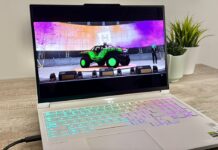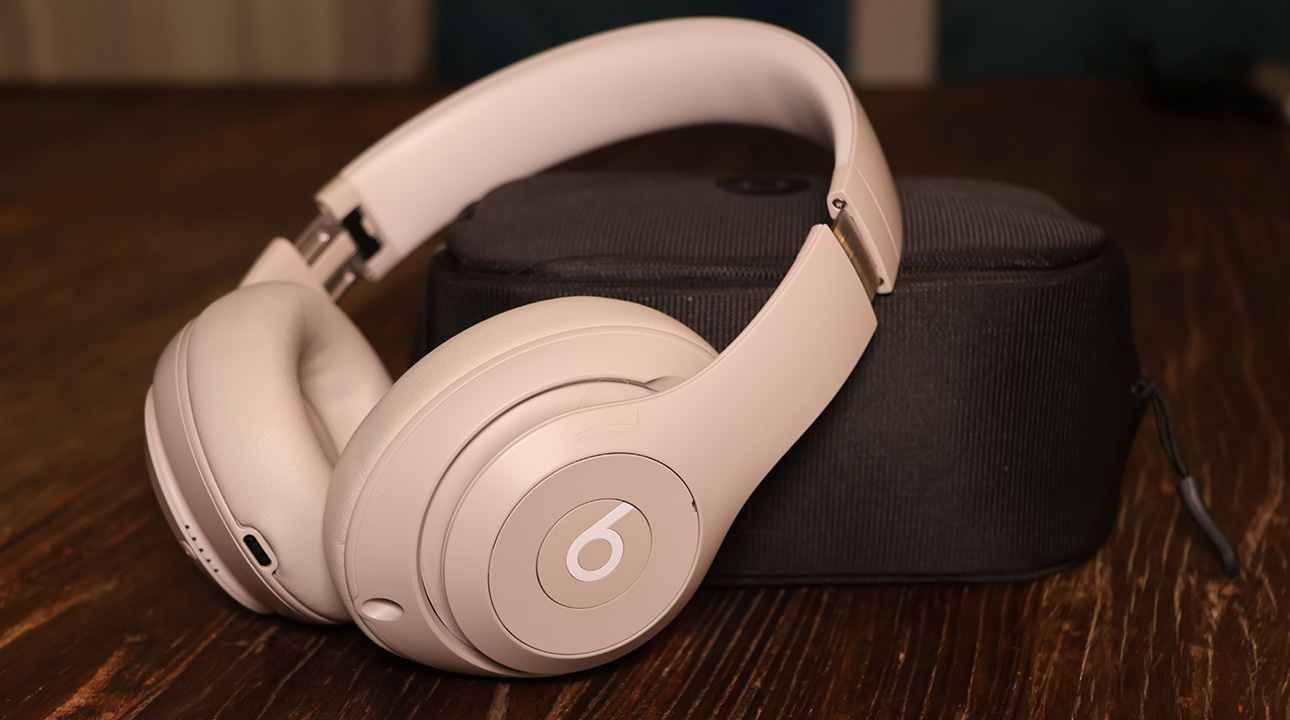
It’s been almost 20 years since Dr. Dre and Jimmy Iovine helped make over-the-ear headphones cool again with their Beats headphones and a decade since the brand became part of Apple. Since that time Beats has continued to develop earphone products under its own marque, continuing to define the Beats legacy apart from Apple. With their latest top-end model, the Beats Studio Pro, the company is leaning into both performance and compatibility—ensuring that no matter what your mobile phone’s ecosystem is, there’s something that works for you to maximize sound, performance, and comfort. Does this latest drop from the brains at Beats live up to the long legacy of the brand, or do they suffer against the stiff competition within this premium sector of personal head-fi? Read on to find out!
Specifications of the Beats Studio Pro headphones
- Dimensions: 18.1 cm x 17.8 cm x 7.8 cm
- Weight: 260 g
- Beats Custom Acoustic Platform 40mm driver
- Active Noise Cancelling and Transparency Modes
- Spatial Audio (Apple device pairing only)
- Bluetooth 5.3
- “b” button for music and call controls
- Apple features: One-touch pairing, “Hey Siri” voice activation, Find My, Over-the-air updates
- Android features: Google Fast Pair, Audio Switch, Find My Device, Beats app
- Clear Calls: Voice-targeting microphones
- Battery life: Up to 40 hours (24 hours with ANC)
- Connectivity: Class 1 Wireless Bluetooth, USB-C audio (with additional EQ modes), and 3.5mm analogue input
- Soft carrying case included
- Colours: Sandstone, Navy, Deep Brown, Black
Unboxing the Beats Studio Pro
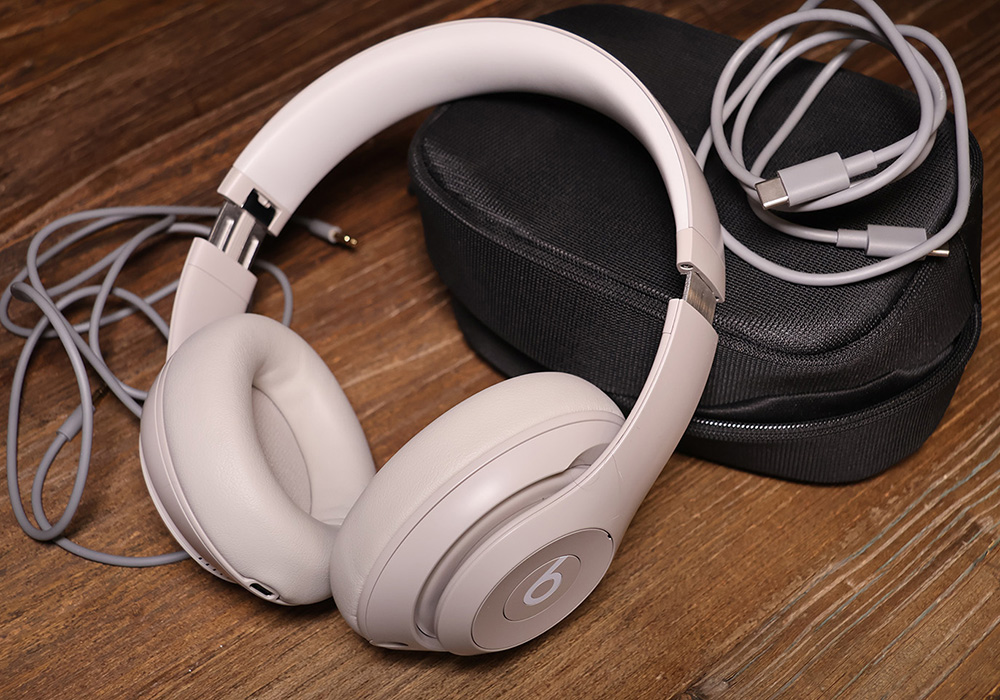
The headphones come in a relatively modest, cleanly designed box made from 100% fibre to prevent excessive plastic packaging. Inside, there’s a lightweight travel case made up of black textured material with a subtle “b” logo embossed on one side. The soft material offers some protection but provides little rigidity when there are no headphones within. The USB-C and 3.5mm TRRS cables are nestled in a pair of pockets, and the headphones themselves fold to tuck into the main part of the case. It will keep dust away from what’s within and should prevent too much harm after a fall off a table, but it’s hardly a bulletproof case.
The headphones themselves are constructed out of a plastic material that feels robust but a bit slick and not quite a premium feel like that of some competing models. The earpads use a synthetic leather-like material, with relatively small ear cups that may or may not work for you. It’s critical to get a good fit to maximize the amount of bass that you’re going to get out of the generous 40mm drivers that serve as their “acoustic platform”.
Wearing the headphones I found the tops of my ears hurting after a while, made worse when I was wearing glasses that interfered with the seal even more. This is exacerbated by the very strong headband spring that did well to lock onto my head—even while walking—but did prove fatiguing after a while both on top of my head, just behind my temples, and below my earlobes.
The most frustrating aspect of the fit is the very narrow gap that forms between the outer frame and the earpads themselves. I was bemused to see that Samuel Ross, the designer tasked with the look and feel of the unit, sports a closely shaved bald head, so clearly he didn’t suffer the same as those of us burdened with more flowing locks. When I first tried them on a giant chunk of hair ripped out on one side, and even after learning to more carefully tuck my hair back (or even to wear a pony tail), errant hairs still managed to get trapped between the earcup and the outer element.
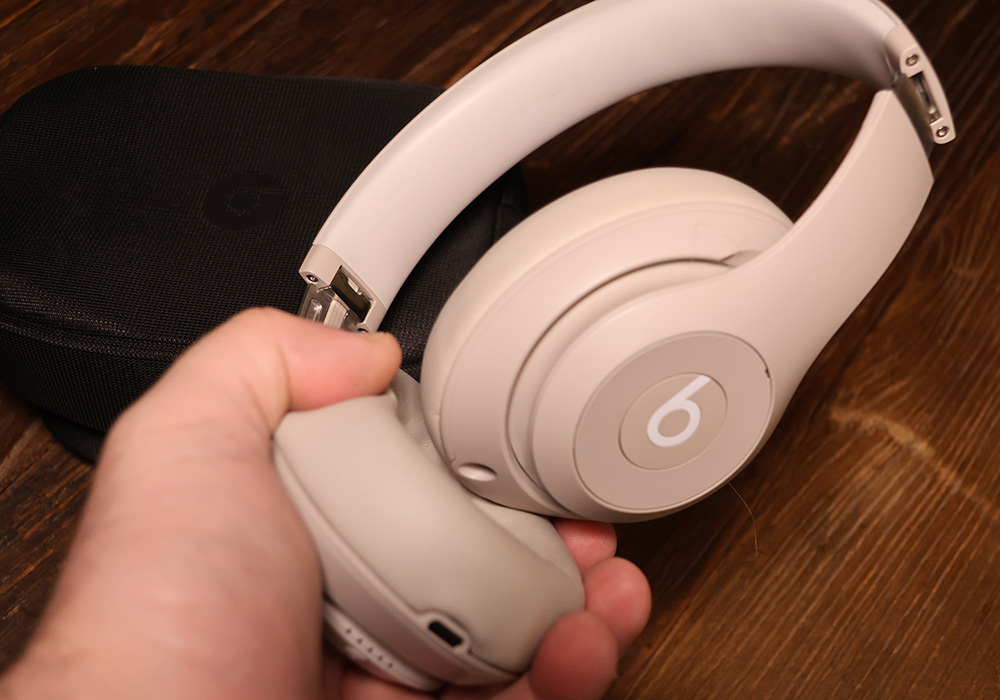
Using the Beats Studio Pro
On the right-side headphones, there’s a small power/system button that allows you to turn the unit on and off, select EQ modes when plugged in via USB, change between Active Noise Cancelling and Transparency Modes, or put the unit into Bluetooth pairing. On the right side, the “b” button serves as a play button, while the ring on the outside lets you adjust the volume. Given that I only realized the function of the outer ring after weeks of wearing them, it may not be quite as intuitive as, say, a dedicated volume rocker like on some other models. But once you know it, you know it.
These big physical buttons are a boon for those of us who constantly and inadvertently change settings while simply adjusting the headphones on our head, but the clickiness of this particular implementation means that it’s quite loud on your left ear when you make a selection. It’s hardly a deal breaker, but it’s something that I never did quite get used to. I find the button locations around the sides of the earcups a more suitable compromise for models that drop the touch panels in favour of physical controls.
Note that on both Apple and Android, there’s a “Find My Device” option, allowing you to track down your model in case it is lost or misplaced and connected elsewhere.
Pairing on Android was painless and quick. The headphones even employ Google’s Fast Pair on devices that support it, as well as Fast Switch to move between your mobile device and Chromebooks or other compatible devices. On iOS the Bluetooth setup was also quick, and there’s an app for both operating systems that allows for firmware updates and the tweaking of a few of the core operating features such as noise cancelling. Apple users get to have “Hey Siri” support with compatible devices, One-touch pairing that syncs with iCloud as centralized management of your devices, and Over-the-air updates when required.
Audio quality of the Beats Studio Pro via Bluetooth
The sound of these headphones is tuned to accentuate low bass and tweak the treble, making for a satisfying if not particularly revealing sonic experience. In contrast with competing headphones in this price range, music sounded involving if noticeably tweaked. Sibilance was rarely an issue, and the spaciousness of imaging was decent enough. However, when listening to more acoustic tracks such as Alison Krauss’ stunning “Paper Airplanes” records or Chet Baker’s mournful “My Funny Valentine”, it was clear that the mid-range frequencies were being softened in favour of a more “smiley face” EQ bumping the bottom and top end. Classical pieces felt more two-dimensional than I prefer.
For those listening to other contemporary pop tracks, this will hardly be an issue given the wildly compressed mixes that are de rigueur, but I still found it somewhat disappointing that I couldn’t refine the sound via a graphic EQ without using third-party applications. The twangy track by Beyoncé “Texas Hold ‘Em” sounded lush and involved. Her even more produced tracks such as “6 inch”, performed with The Weeknd, felt powerful but still slightly constrained. I found most music from the top 10 well reproduced but lacking some of the sparkle and sense of involvement similar spec models from some competitors offer.
That said, there’s still a significant jump up in quality from many other lesser circumaural models, and many who may have grown up for years with the Beats signature sound may well prefer these to other models that may provide less attenuated soundscapes but may for them lack a bit of the “punch” that they’re looking for from their favourite tracks.
The device’s Bluetooth 5.3 implementation provides an extremely good range for the headphones from the transmission device, but, unfortunately, there are no advanced streaming codecs that allow higher quality modes such as LDAC or Apt-X HD.
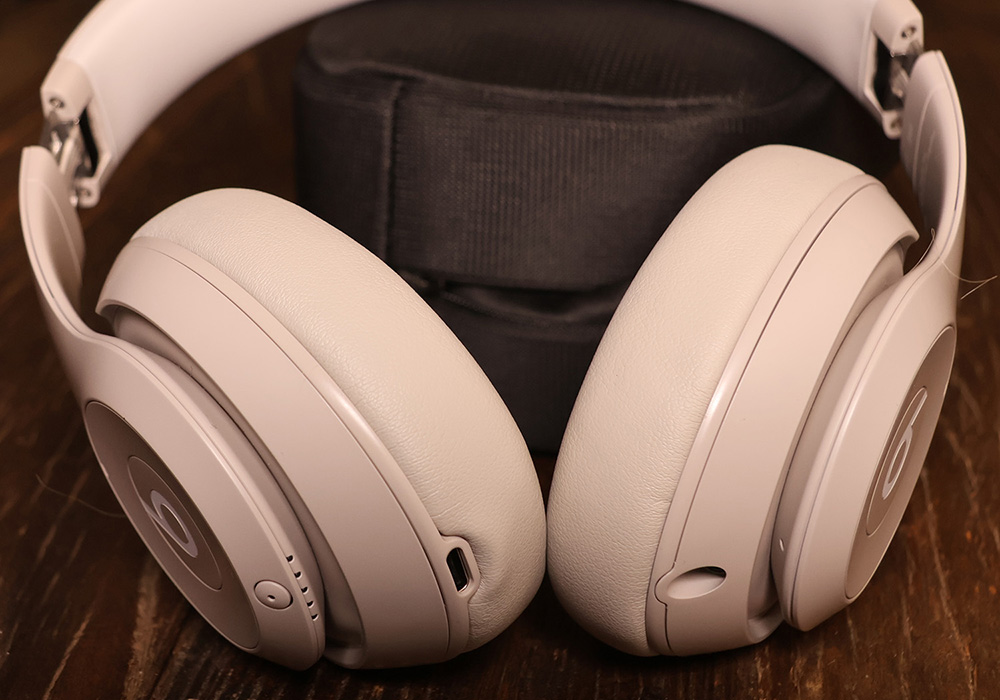
Using a wired connection with the Beats Studio Pro headphones
A major plus on these headphones is the ability to use a wired USB-C connection that bypasses the limitations of Bluetooth—providing true lossless digital audio (up to 24hz/48khz) that’s superior to any Bluetooth mode. This essentially turns the inner amplification into a USB soundcard. The improvement of audio is immediately apparent, even from streaming services, with an improvement in soundstage and, critically, maximum volume for those tracks that need a bit of boos to elicit all the detail in the mix.
When using USB-C to connect to your device you can select between three different equalization modes by pressing the “system” (aka power) button on the right ear cup. There’s no feedback provided about what mode is selected save for some lights on the outside, so there’s a good chance that you may accidentally kick it out of your preferred mode when adjusting your headphones on your ears. The default mode is “Beats Signature”, indicated by a single light in the middle of the five-dot display, which, apparently, is “well-suited to all genres of music”. “Entertainment” is indicated by dots 2 and 4, which seem to further emphasize the already elevated low-bass and treble frequencies, essentially an even more smiley face curve. Finally, there’s “Conversation” with lights 1, 3 and 5 illuminated, which removes much of the bass frequencies and optimizes for voice, likely to be selected by those either listening to podcasts or making calls.
Another major advantage of plugging in via USC-C is, of course, that you can charge and listen at the same time—perfect for when you’re using them plugged into your computer and not wanting to worry they’ll die during a mix. If you’re using this with a USB-C Apple device you’ll either need a dongle or a USB-C lightning cable to make this work for you.
Note that because it’s reading the digital signals directly, some formats will not work via this mode. For example, on my portable player, I was unable to play raw DSD files or any FLAC files above the 24/48khz limit. For those files you’ll either need to use Bluetooth (that will, of course, send a reduced signal) or the 3.5mm option. In both USB-C and 3.5 modes, the volume rocker on the left ear pad did nothing, meaning you lose out on another part of convenience by being tethered.
Connecting via 3.5mm doesn’t always bypass all internal amplification and makes the headphones behave like regular wired headphones, but in this case, I was pleased that indeed the Beats behaved as desired. Of course, given the fact that the internal processing is bypassed for both USB-C and 3.5mm, you’re no longer able to have any noise cancellation or transparency modes available. Given that wired connectivity is ideal for close listening sessions, the switch over to wireless when in noisy environments is a small price to pay.
Active Noise Cancelling on the Beats Studio Pro
Noise Cancelling on the Beats Studio Pro is definitely one aspect of these headphones that approaches class-leading and rivals that of many of its competitor’s offerings. The headphones do an excellent job of attenuating a wide range of frequencies, and even on crowded subways and noisy planes with screaming children, the Beats delivered. You can change modes either by the system button or via the app in both iOS and Android, though given how effective it is without messing up the sound too much I left it on even in quiet environments.
While there’s no advance tweaking that can be done, by simply selecting the Noise Cancellation Mode you’re immediately plunged into a more pristine listening environment. There’s nothing in the way of that “sucking” feeling that some headphones generate, and there was very little in the way of additional sound sculpting that differed between when it was engaged and was not.
The Transparency Mode did well to keep the tunes working while still being able to hear enough of the outside world to either communicate or to be safe while commuting. It should be noted that when wearing the headphones outside during windy days there was still quite a noise that would transmit from the surface itself, often to the point of overwhelming the noise cancellation.
Personalized Spatial Audio on the Beats Studio Pro
Apple users get to take advantage of the Personalized Spatial Audio features of the headphones, allowing for a kind of surround sound that’s particularly of benefit for both music mixes and video streams. When listening to multichannel mixes the headphones track your movements, creating a virtual room of sorts where the sounds emerge from various locations. While Android users are out of luck, so too are users of older iOS models such as my iPad I’ve had for a few years. In fact, the only device I have in my arsenal that could pair with the Beats that gave spatial audio was my Apple TV 4K, and I was pleased at the ability to so easily connect.
For key apps such as Disney+ and Netflix you can have surround mixes, which means that when you rotate your head the sounds move around in tandem. It’s all a bit of a gimmick, made all the more silly given the fact that I was listening in an actual Atmos-capable theatre. Like with other 360 sound options the results are mixed, and obviously pale to true surround setups. Still, it’s a fun thing to play with occasionally, even if I’d never select it over a proper stereo mix for the stereo drivers. While I was unable to get spatial audio to work with Tidal’s Atmos mixes, users of Apple Music may have better luck—and this is one instance where perhaps the post-processed surround is a preferred option while listening to headphones over the standard 2-channel mix given that these options usually have far better dynamic range as they are meant for more critical, immersive listening situations.
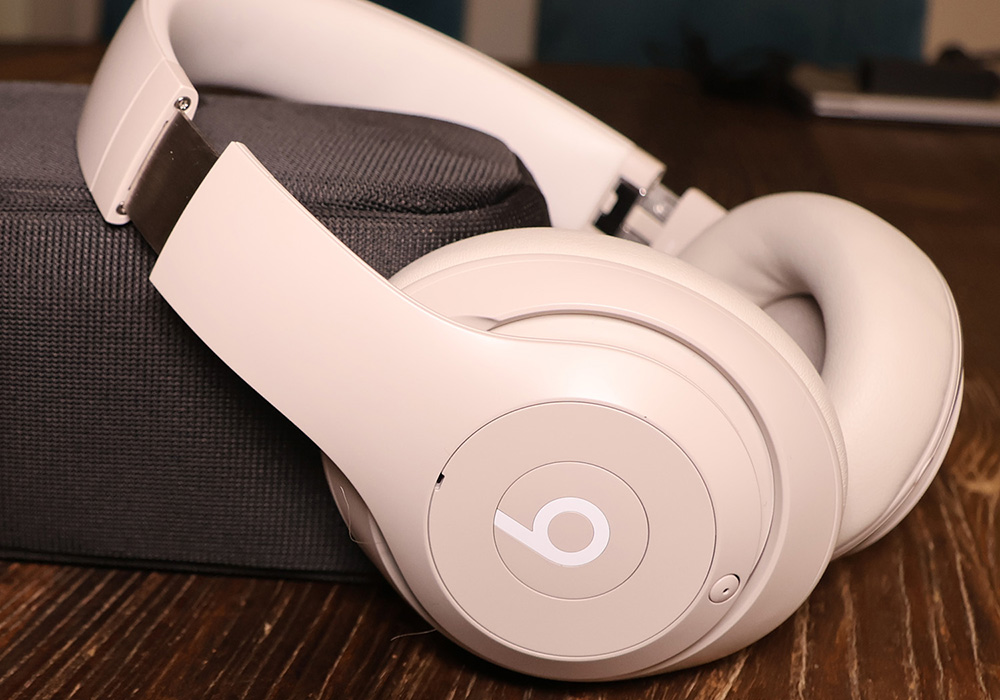
Final thoughts on the Beats Studio Pro headphones
I enjoyed my time with the Beats Studio Pro headphones, and I can see why so many for years have flocked to this brand’s models for their daily drivers. I applaud the ability to use USB-C and 3.5mm connectors for wired solutions and celebrate effusively the clearly deliberate fashion in which this Apple product has gone out of its way to be compatible with its own ecosystem and Android’s for the vast majority of features and capabilities.
For my own taste, I prefer the more laid-back, neutral sound from some of its competitor’s similarly priced models, and I believe that adding tweakable EQ to customize the sound modes and make switches within the app is an easy and necessary improvement for potential future app and firmware updates.
Still, these are a highly refined, well-designed pair of headphones that, depending on your listening choices, may well be your preferred purchase. With excellent noise cancellation, flexibility of operation, good sound, and a compact package, there are many for whom the Beats Studio Pro headphones will be their ultimate device for everyday listening while on the go or in front of their system.





